
Today, we are taking a look at the World Bank’s financing of dams. The World Bank has been the largest single source of funding for dam construction around the world. Critics note that under its stated aim of alleviating poverty, the bank has promoted and financed dams that have displaced over 10 million people from their land. The projects, they say, also cause severe environmental damage, and push developing nations further into debt. Activist groups charge that the World Bank has not been forced to pay for the destruction it has caused to millions of people’s lives and the environment. [includes rush transcript]
A growing movement of dam-affected communities worldwide is demanding reparations for the damage caused by these dams.
Guests:
- Carlos Chen, a survivor of the 1982 massacre by the Guatemalan military in the Maya-Achi community of Rio Negro. 107 children and 70 women were killed, including Carlos’ pregnant wife and two infant children. They refused to leave their lands to make way for dam construction. He is in Washington this week, demanding reparations from the World Bank and the Inter-American Development Bank, who financed the dam project. Translated by Graham Russell from Rights Action.
- Venu Govindu, spokesperson, Friends of Narmada. He runs a website focusing on the Narmada dam project in India.
- Aviva Imhof of the International Rivers Network, which has helped communities fight against the building of dams.
- Maninder Gill, Coordinator of the Resettlement Thematic Group at the World Bank.
Related links:
Transcript
AMY GOODMAN: We continue our weeklong series on the protests that are happening in Washington, D.C., culminating in attempts this weekend, on Sunday and Monday, of thousands of activists from around the world to close down the meetings of the World Bank and the International Monetary Fund, as protesters call for the tanking of the bank and the defunding of the fund.
Well, today we’re going to take a look at a very controversial area of World Bank financing, and that is dams. The World Bank has been the largest single source of funding for dam construction around the world. Critics charge that under its stated aim of alleviating poverty, the bank has promoted and financed dams that have displaced over ten million people from their land. They say the projects also cause severe environmental damage and push developing nations further into debt.
A growing movement of dam-affected communities is demanding reparations for the damage caused by these dams, and a number of representatives will be in Washington and, in fact, held a vigil last night in the nation’s capital.
We’re joined today by an array of people, including a representative of the World Bank who deals with the issue of resettlement, but first we’re going to turn to Aviva Imhof of the International Rivers Network which has helped communities fighting against the building of dams around the world.
Aviva Imhof, welcome to Democracy Now!
AVIVA IMHOF: Thank you, Amy.
AMY GOODMAN: Well, can you start off by talking about the overall international landscape of dam politics?
AVIVA IMHOF: Well, as you said in the introduction, the World Bank has been the largest source of funding for large dams worldwide until now. But actually the bank’s funding for dams has decreased significantly over the past few years, and that’s because of the growing international movement opposing large dams, so opposing both in developing countries and in developed countries, as a huge movement of activists that are fighting these projects.
And currently in the international arena, one of the things that’s going on is the World Commission on Dams. It’s a commission that was established in 1997 by both industry, NGOs, as well as the World Bank was involved in its establishment. And this institution is currently looking at the development effectiveness of large dams, and it aims to come up with criteria and guidelines for future dam construction. And that institution’s report is due out by the end of this year.
One of the interesting things about the WCD is that the commissioners, which include an array of people representing various interests, have now agreed on the principle of prior informed consent. What that means is that they’ve agreed that all dam-affected or potentially dam-affected communities have the right to be informed and to say no to a project, and that’s really significant. The World Bank has never adopted a principle like this in any of their resettlement policies.
AMY GOODMAN: We’re also joined on the telephone by Venu Govindu, a spokesperson for Friends of Narmada, which is a dam project in India that ultimately led to, because of protest, led to the World Bank pulling out. Venu Govindu, can you give us a lay of the land of the Narmada Project and what happened and what the objections were?
VENU GOVINDU: Thanks, Amy.
AMY GOODMAN: And tell us where Narmada is.
VENU GOVINDU: So the Narmada River is actually in Central India, and it flows westward and flows into the Arabian Sea. And the government of India’s project has essentially been a large scheme to actually develop thirty large dams, 135 medium-sized and about 3,000 minor dams on the Narmada and its forty tributaries.
In particular, the movement against large dams has been centered around the Sardar Sarovar project, which is the largest dam on the river that has been planned and had been under construction.
The original funding and the impetus for the dam actually came from the World Bank at a point where the government of India was not willing to provide the clearances, direct the clearances for construction to go ahead, because a proper master plan was not in place. The World Bank stepped in and was willing to fund the project to a tune of $450 million, which provided a lot of legitimacy for the project at a point where there was serious lacking in the whole planning process. And it also enabled many bilateral agencies to step in into the project. So that’s an important thing.
As Aviva pointed out earlier, I mean, the whole notion of prior informed consent was never really part of the whole planning process and the whole idea of taking people in a democratic society into confidence and trying to have a dialogue with the people. So the whole movement, the campaign against Sardar Sarovar and other dams in the Narmada Valley, was basically a reaction to many of these serious, serious problems and also to the failure of proper — failure on the part of the [inaudible] of the dam for a proper cost-benefit analysis. And today, our understanding is very clear that the costs don’t justify the benefits. I mean, even if you forget about the social and human aspects, just in very pure classical economic terms, the costs don’t justify the benefits.
AMY GOODMAN: But, Venu Govindu, could you explain for listeners who have never heard of the Narmada Dam the scale of the protest and why specifically people were against it?
VENU GOVINDU: [inaudible] dam is going to be — if it ever were to be constructed [inaudible] to be constructed 455 feet, and it would submerge thousands of hectares of land and would displace many thousands of families. Now, today, the figures of the total affected communities runs close to 400,000 people, and that includes the people who are directly in the reservoir submergence area, the people who are downstream, the people who are going to be affected by a compensatory forestation.
So the protests were actually sort of an evolution of the understanding of how the development policy and the planning operated at the ground in India or in many other developing countries, at a point where people were really not even sure what was going on. I mean, there was a whole attempt of a dialogue with the government and trying to get the government —- people were trying to assert their right to information, and at the same time there was a simultaneous movement of independent experts and individuals all across the world trying to understand the cost-benefit analysis. So the scale of the protest is obviously due to the tremendous impact that the project is going to have on -—
AMY GOODMAN: What did the protestors do?
VENU GOVINDU: Well, the protest was a nonviolent protest, to start with, and initially the protests were peaceful demonstrations for right to information, and throughout, the protests have been basically adaptation of what in India we would call a Ghandian-style protest, which are nonviolent protests demanding and asserting people’s right to know, people’s right to land and the communities’ right to actually have a say in the process planning. So there have been a whole series of protests, including —
AMY GOODMAN: Did they go to the dam site?
VENU GOVINDU: Well, so there was an attempt in 1990, where the people actually — what is now almost mythical proportions — there was a protest called the Long March, where thousands of people marched for many, many days to try and reach the dam site and voice their opposition to the project. They were not allowed to do that by the government of Gujarat, where there was, you know, a huge police force and fierce concerns of repression going on, so the protests have been at many scales and at many levels. And the reaction of the state has been very typical of essentially trying to put the lid on it, of being repressive, and not really dealing with the fundamental questions that people were raising.
So, in fact, last year, for example, when after the Supreme Court gave an interim order to raise the height of the dam by about eight meters, which would in turn have affected many, many more communities, the people were sitting on the land in protest in the watch zone as a satyagraha, which basically means it’s a nonviolent protest for truth. And people, including activists of the Narmada Bachao Andolan and the indigenous communities that were affected and people from all over the country who were concerned, were sitting in peaceful protest and said that “We would face the waters, we would rather drown in the waters than leave our land.”
AMY GOODMAN: And so, what happened?
VENU GOVINDU: So, there was a series of protests, and whenever the waters would rise to a significantly dangerous level, the state would step in, arrest the people and cart them away. In fact, the arrests were themselves shown to be illegal, but that’s the manner in which the state has been operating, by using the police force and the legal mechanism just as a way of quelching democratic protests and dissent, rather than really dealing with the serious underlying problems with the project.
AMY GOODMAN: Venu Govindu is spokesperson for Friends of Narmada, runs a website, www.narmada.com, on the dam project in India.
We’re also joined on the phone by Maninder Gill, who is coordinator of the Resettlement Thematic Group at the World Bank. Welcome to Democracy Now!
MANINDER GILL: Thanks, Amy.
AMY GOODMAN: Could you give your response to the kind of criticism that we’ve heard Aviva Imhof of the International Rivers Network and Venu Govindu give right now of dams and the associated issue of resettlement of people?
MANINDER GILL: Yeah, thanks. Let me start by saying that I agree with Aviva that the Bank is now doing a much smaller number of dams than it was until about a decade ago, and part of the reason also is that the Bank has established what is known as probably the best resettlement policy in the world. And many of our borrowers do find it difficult to comply with standards as high as those established by the Bank, not to say that those dams don’t get built, but we are afraid they are built through other sources of funding or by the national governments themselves to a much lower standard than the one which is a requirement, as far as the Bank is concerned. But we are doing a much smaller number of dams now and at a much higher standard. I guess we’ve learned a lot in the last ten, fifteen years. There have been a number of reports of our independent operations evaluation department, which has documented the issues and problems of the past and how we can learn from them and then address those in the policy and in implementation.
AMY GOODMAN: Maninder Gill, we have to break for stations to identify themselves, but you can continue your thought after the break. Maninder Gill is coordinator of the Resettlement Thematic Group at the World Bank. Aviva Imhof with the International Rivers Network. And Venu Govindu of the website www.narmada.org. That’s narmada.org. You’re listening to Pacifica Radio’s Democracy Now! We’ll be back with them, as well as a Guatemalan, to talk about situation of a dam there, when we return.
[break]
AMY GOODMAN: As we continue our teach-in on World Bank and IMF policies, we’re joined by a coordinator for the World Bank for the Resettlement Thematic Group there, Maninder Gill. Aviva Imhof is with us, of the International Rivers Network. Venu Govindu, a spokesperson for Friends of Narmada.
Maninder Gill, you were just talking about how the World Bank has learned over the last ten or fifteen years a lot about the issue of resettlement.
MANINDER GILL: Right. Also, though, I’m not sure if the number of ten million people displaced by the World Bank, by World Bank projects is correct, but we do know that we contribute less than 3% of the resettlement caused by dams in the world, and we are not satisfied just by ensuring that high standards are maintained as far as resettlement of this 3% of people is concerned. So over the last five years or so, we have worked with many of our borrowers to strengthen their own national and local resettlement policies and frameworks, because we feel that the development impact of a better policy at the local and national level is much higher than a good policy at the World Bank level. And there are many states, countries, corporations, which have adopted the World Bank standards, in addition to, I think, almost all multilateral/bilateral agencies which have modeled their own policies after the World Bank’s policy.
AMY GOODMAN: Aviva Imhof, how do you feel, from the International Rivers Network, about the World Bank changes and overall policies?
AVIVA IMHOF: Well, the policy may look good on paper, but every single internal bank review that has been done looking at the impact of the Bank’s resettlement policy has found it to be an unmitigated failure. Every single bank review has pointed out that the goal of the policy is income restoration, but in most cases the bank doesn’t even have enough data to be able to say whether people’s income has been restored. They don’t know how many people were resettled by a particular project, and they simply haven’t monitored what’s happened to people after they have been resettled. I mean, the only reason for the decrease in bank funding for large dams in recent years has been because of the enormous opposition to these projects. It’s simply harder for the Bank to pour money into large dams.
But it doesn’t mean they’re not doing it. They’re doing it in China. They’re trying to do it in Laos. They’re trying to do it in Uganda, Bujagali Falls Dam there. The Bank is still trying to fund large dams, and there are also their ongoing projects and now currently forcibly displacing 3.3 million people. That’s an internal Bank figure. So it’s simply not true that the Bank has moved away from financing, you know, projects involving involuntary resettlement and that they are doing it better. They’re actually an example of worst practice, rather than best practice, and what we’re saying is that if the Bank’s internal reviews have consistently shown that the Bank has failed to adhere to the stance of its policies and that the Bank’s projects have impoverished people, the Bank shouldn’t be financing any projects involving involuntary resettlement.
AMY GOODMAN: Maninder Gill of the World Bank?
MANINDER GILL: See, the development paradigm of almost all countries of the world has involved dams at some stage of their development, so as long as the borrowers and the countries themselves feel that dams and the associated benefits of energy, water supply, flood control have about alleviation impact, and the fact that everyone, every major country in the world, has relied on this form of development for development, for poverty alleviation, the Bank would certainly like to partner in the efforts to make dams, making sure that they are environmentally and socially sustainable, and that’s where the challenge has been and that’s what we are focusing on now.
AMY GOODMAN: Let me ask you about the situation where the World Bank works with a government that is not supported by the people, that is there because of its massive military force and military repression. They like massive centralized projects because they can skim a lot of money off the top.
I wanted to go now to Guatemala to Carlos Chen, who is a survivor of the 1982 massacre by Guatemalan military in the Maya Achi community of Rio Negro. 107 kids and seventy women were killed, including Carlos’s pregnant wife and two infant children. They refused to leave their lands to make way for dam construction. Carlos Chen is in Washington this week, demanding reparations from the World Bank and the Inter-American Development Bank, who financed the dam project, granted with the support of the Guatemalan government at the time, the Guatemalan military regime. Carlos Chen is translated by Graham Russell. Can you tell your story, Carlos Chen?
GRAHAM RUSSELL: Well, on behalf of Carlos Chen, greetings and thank you for having us on the program. And we prepared a short statement on Carlos’s behalf that I will read and then open it up for larger discussion.
AMY GOODMAN: Let me just interrupt and just say in the background, if you could turn down your radio. And is Carlos there?
GRAHAM RUSSELL: Carlos is standing right beside me. Hang on one sec.
CARLOS CHEN: Hello. Buenos dias.
AMY GOODMAN: It’s good to have you with us.
CARLOS CHEN: Thank you. Muchas gracias.
AMY GOODMAN: The statement. We just need to have it quiet in the background.
GRAHAM RUSSELL: Yeah, I’m sorry about that. There’s a lot of other people around. There’s no radio on.
AMY GOODMAN: You’re listening to Pacifica Radio’s Democracy Now! OK, go ahead.
GRAHAM RUSSELL: [reading on behalf of Carlos Chen] The brief statement is that this dam, like other speakers have said, was imposed on the community in the late '70s and early ’80s. There was little to no consultation whatsoever. It's called the Chixoy Dam. The World Bank and the Inter-American Development Fund provided over $200 million worth of funding. They were partnered at that time with the Guatemalan government, which was a military dictatorship fully sponsored and supported by the United States.
And what happened was the convergence of the dam project came together with an increase in repression in Guatemala at that time. And as the community was in opposition to being forcibly relocated without consultation, they were increasingly being identified in the press and by the government as guerilla supporters. And at the same time that the dam project proceeded, they started a series of massacres by army soldiers and civilian defense patrollers from the next town over against the people of Rio Negro. In 1981 and in 1982, there was five different massacres of the people of Rio Negro, including the one that was just mentioned on March 13, 1982, whereby Carlos’s first wife and two infant children were killed.
Since that time, the resettlement policy took care of itself. The banks and their partner in the Guatemalan government did not have to relocate the people, because the massacres took care of that. Shortly after the last massacre took place in mid-1982, the dam basin was filled, and the survivors of the town of Rio Negro were scattered to the Four Winds. To this day, they have received little or no compensation that was promised to them by the Guatemalan government through the bank-sponsored project, and the majority of the survivors are living in a small community called Pacux in conditions of poverty, still suffering from the trauma of the massacres that they suffered [inaudible].
AMY GOODMAN: Let me ask Carlos Chen: what are you demanding now?
CARLOS CHEN: [translated] The first thing that we are demanding is to open up a process of negotiation with the two banks, so that we can discuss with them reparations and compensations for the destruction they caused in the town of Rio Negro. So, one aspect of the compensation would have been land, and we had very good land, some twenty-two cabellerias, and to this date we have only received seven cabellerias, and most of that land is of poor quality.
Another element that we are asking for is reparations for the survivors. Most of them are women, because their husbands were massacred for being in opposition to the dam, amongst other reasons, and since that time they have lived in conditions of extreme poverty with no economic opportunity and no land to work on.
AMY GOODMAN: Let me put the situation to Maninder Gill of the World Bank. When you hear the description of this, what is the World Bank — how is the World Bank dealing with the survivors of the 1982 massacre for the clearance for the dam that the World Bank financed there?
MANINDER GILL: Yes, Amy, first of all, let me confess that I don’t know enough about the Chixoy Dam, because I haven’t personally worked in the region or in the project itself. But I have spoken to my colleagues and I have reports, so I know a little bit of the history. And I have a better idea of what is going on right now and what the proposals are for the immediate future.
One, I think what happened in Rio Negro is extremely tragic, and I don’t think anything can undo or compensate for that extreme tragedy and the loss of the families and the community. And it’s a very, very unfortunate — it was an unfortunate event and part of a much larger tragedy in the Rabinal area, where I think many thousands of people were killed in those civil war years. So that’s extremely tragic.
AMY GOODMAN: But on that issue, the issue of the World Bank shoring up the regime, when it knew that, you know, the massive number of casualties were certainly inflicted by the Guatemalan military and their paramilitaries.
MANINDER GILL: During those years, I think there was very little information flowing out on what is happening in the particular project area, and because of the civil war, my sense is that supervision missions and other discussions with the Guatemalans were on hold or were not — they were discontinued for a few years. And it was much later that Bank missions, while supervising the project, realized the scale of the tragedy and what had transpired and then raised the issue immediately with the government of Guatemala to put in place a much stronger resettlement plan and to work with them on its immediate implementation. Now, that’s what Carlos just said, I think it’s key that if the elements of the resettlement plan that was agreed with the Guatemalans and the communities and have not been fully implemented, that’s the absolute first task which we have to undertake. And, again, I think we need strong collaboration with NGOs who are interested in this process with the local communities and agree on what needs to be done and then work very hard to implement it.
AMY GOODMAN: Aviva Imhof of the International Rivers Network?
AVIVA IMHOF: It’s simply not true that the Bank was not aware of what was happening at the time, and if they weren’t aware, it would have been a gross act of negligence. And I think that Graham and Carlos can reply to that more fully, but certainly the only reason that the Bank has done anything in recent years has been due to pressure from the communities and from human rights groups overseas. And the Bank has simply not restored people to their — at least restored people to their former standard of living or improved their lives, and I think Carlos and Graham can speak [inaudible].
AMY GOODMAN: Graham Russell of Rights Action who is translating for Carlos Chen.
GRAHAM RUSSELL: Yes. I was just translating to Carlos Chen this recent conversation, and he made two points. The first point is that with respect to future compensation and reparation based on the agreement that was arised at, he reminds that there was no real negotiation process initially, so that the so-called agreement is a faulty agreement to begin with. Now, there are elements there that they are willing to negotiate, but they have to remember that it was almost a situation of coerced agreement.
The second point he says is that while it was certainly sad what it happened, he does not call it unfortunate or tragic. These were crimes committed. There was a state policy in place of massacring people, and that the two banks and then some other international companies working on the dam knew exactly who they were working with, and that there was huge amounts of international information, whether through Amnesty International or the United Nations at that time, denouncing internationally what the Guatemalan government was doing. So, it’s not a question of unfortunate or tragic events. They were crimes.
AMY GOODMAN: We have to wrap up the discussion, but I wanted to end with this bigger point, Maninder Gill of the World Bank, and that is these massive protests are going to be taking place this weekend, and I’m sure, just personally for you, this is making a big difference for you and your colleagues at the World Bank, but this overall point that goes beyond the individual dam projects that the World Bank shores up, these massive multi-million dollar projects that shore up governments that are not responsive to the people. So while you say you work with the country, what the people on the ground say is that they are the victims of two entities: their own governments that profit from the World Bank and the corporations that do, and the World Bank, you know, making it possible for them to continue with their support.
MANINDER GILL: I would just say the lessons we have learned on participation of local communities and the people who both benefit and suffer some adverse impacts from projects, these lessons would absolutely prevent us from working in a project where the people who are going to be a part of the project are not fully involved in the project, they fully endorse the project, and are willing to be partners in its implementation. I don’t think it’s possible for the World Bank or any international organization to participate in projects that are only dealing with the national governments, ignoring local communities. That’s simply not the way we can do business.
And the resettlement policy of the Bank places a lot of emphasis on the importance of participation, and though what Aviva said about informed consent, we are not aware of any recommendation from WCD, because it’s still work in progress, but —
AMY GOODMAN: What is WCD?
MANINDER GILL: This is the World Commission on Dams, which we were —
AMY GOODMAN: Right, right.
MANINDER GILL: — just mentioned. So whether it’s informed consent or not in the policies, I think the involvement of people, their endorsement of the projects that affect their lives, is absolute critical element of any project that the World Bank finances today.
AMY GOODMAN: Are these protests having an effect on you and your colleagues?
MANINDER GILL: Well, we are in touch with many of the protesters on a regular basis as part of our collaboration with NGOs and our critics, and many of the protesters would know that we take great care to explain to them what sort of changes and improvements we are incorporating in our policies and in our implementation practice.
AMY GOODMAN: Will you be going to work on Monday?
MANINDER GILL: Yes, I will be going to work on Monday and over the weekend, also.
AMY GOODMAN: Even if the protesters form a chain around the World Bank?
MANINDER GILL: Well, we are dealing with some very sensitive projects and very important issues, so I intend coming to office all the weekend and on Monday. If I am physically prevented, of course, I will not be able to come to work, but that’s the intention at this point.
AMY GOODMAN: Maninder Gill of the World Bank, what is the website of the World Bank, if people want to read about your policies and projects?
MANINDER GILL: Yeah, it’s www.worldbank.org.
AMY GOODMAN: And, Aviva Imhof, International Rivers Network, with final comment?
AVIVA IMHOF: Yes. I’d just like to say that —
AMY GOODMAN: We just have twenty seconds.
AVIVA IMHOF: OK, the Bank is actually in the process of downgrading its resettlement policy and making the provisions in it weaker than they were before. One of the things that they’re doing is they’re going to not — the policy will not apply to people who are voluntarily resettled, and 90% of the Bank’s voluntary resettlement, or so-called voluntary resettlement, is happening in China, where we can really question whether the resettlement is voluntary or not.
AMY GOODMAN: And the International Rivers Network website?
AVIVA IMHOF: Www.irn.org
AMY GOODMAN: Venu Govindu, spokesperson for Friends of Narmada, that website www.narmada.org. And Carlos Chen, survivor of the Guatemalan military massacre after people protested a World Bank-sponsored dam project there — website or contact information, Graham Russell?
GRAHAM RUSSELL: I would think at this point the best way would be to get in touch with Carlos Chen through the IRN website.
AMY GOODMAN: And that, again, is irn.org.

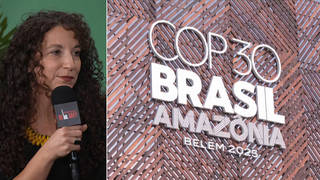
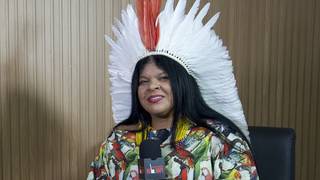
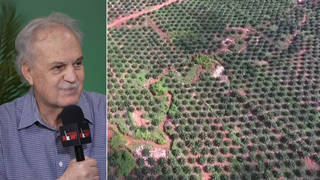
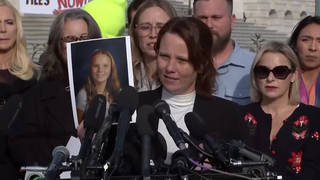





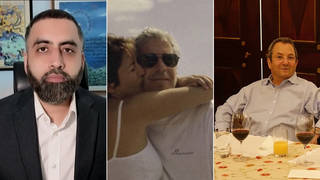
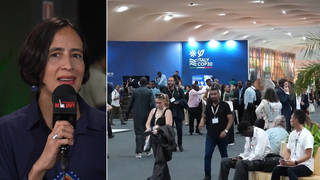
Media Options